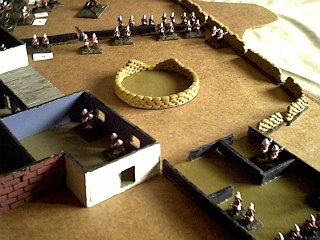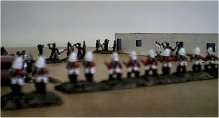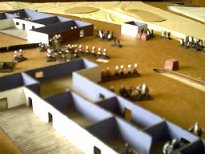|
|
|
 |
||
That Damn Train! |
||
Introduction |
||||||||||||||||||||||||||||||||||||||||||||||||||||||||||||||||||||||||||||||||||||
|
These rules were written for refighting the "classic" Zulu attack on Rorkes Drift in 15mm. The rules could easily
be expanded to cover any of the anglo-zulu fights.
|
||||||||||||||||||||||||||||||||||||||||||||||||||||||||||||||||||||||||||||||||||||
Playing Equipment |
||||||||||||||||||||||||||||||||||||||||||||||||||||||||||||||||||||||||||||||||||||
BasingFigures for both the Zulu’s and the British should be based in pairs on a rectangle one inch wide by three quarters of an inch deep. Each thus based figure-pair is refererred to in these rules as a base.For refighting Rorkes Drift you will require 39 British bases and only 43 Zulu bases. Turn SequencePlayers take alternate turns. A turn contains the following phases.
Move PhaseDuring this phase a player may do one of a number of things with each base. Zulu bases may be moved up to 4 inches in any direction. British bases (including any other non-Zulu races) may be moved up to 3 inches in any direction. You should measure movement from centre of base to centre. A base may end it’s turn facing any direction. There are a number of restictions that apply to these movement allowances, as follows. Climbing through a window takes an entire turn. The base concerned must start the turn at the base of the window, and will end the turn on the opposite side at the base.
Climbing through a window takes an entire turn. The base concerned must start the turn at the base of the window, and will end the turn on the opposite side at the base.
Passing through a door reduces movement for the turn by one inch. To climb a mealie bag wall, takes a full turn. The base concerned must start the turn at the base of the wall. It is assumed to be on top of the wall at the start of the next turn and may move freely. Excepting that it is not possible to proceed along the top of the wall. To cross a two/three bar fence reduces movement by two inches. Wounded Red Coats have their movement reduced by one inch. Fire PhaseOnly bases carrying rifles may fire. Bases may only fire forwards across an arc of roughly 90 degrees centred on directly ahead.Obviously an eligible target must be at least partially visible to the firer. To hit a target the firer rolls a die. This result is compared against the firing table. The die score must be equal to or greater to score a hit. In order for you to interpret the table some short example of the type of shot possible must be made.
Any Zulu target hit is removed from play. When a Redcoat base is hit it causes a wound. Melee PhaseMelee occurs when any two opposing bases are in base to base contact, or in contact on opposite sides of an obstruction that would allow them to melee against each other (eg a mealie bag wall).Each player in a melee rolls one die. The Highest scorer wins the melee. There are however a number of modifiers that are applied the die results.
Any Zulu base that loses a Melee is removed from play. When a Redcoat base is hit it suffers a wound. 
MoraleMorale is only applied to the Zulu player.At the end of each Zulu Turn count the number of Casualties. You must then compare the number of casualties on the following table.
Roll a D10. If the result is greater than or equal to the ‘Retreat’ column figure then the Zulu player must must commence a withdrawl and continue withdrawing until all Zulu figures are off of the board. During this withdrawl time the Zulu player must move at least half of his figures their full movement allowance towards the edge of the board. The Zulu player may not bring on any more figures while withdrawing. Once the Zulu player has withdrawn all figures from the table he must spend time recovering, as follows. He secretly rolls a D10 and may not commence another attack for that many turns. Wounds If a Red Coat has a wound marker, and then suffers a second wound it is removed from play.
If a Red Coat has a wound marker, and then suffers a second wound it is removed from play.
Before the game starts the Red Coat player must specify one room in either the Store or the Hospital as the ‘Surgeons Room’. A Red Coat base with a Wound marker may be seen by the Surgeon in the ‘Surgeons Room’. If a base spends a whole turn in the room without moving, firing or meleeing roll a D10. On a score of 10 the wound marker may be removed. NighttimeThe onset of night will reduce the effective range of the firearms. The referee must decide when Twilight has arrived. During Twilight no shots may be made over 20 Inches.
The referee must decide when Twilight has arrived. During Twilight no shots may be made over 20 Inches.
The referee must decide when “Full Dark” has arrived. During “Full Dark” no shots may be made over 10 inches. FireWhenever a melee takes place with opposing elements inside a room there is a chance it may cause a fire. You should only check for fire once per room per turn no matter how many melee’s take place inside it.To check if a fire starts roll 2D10. On a score of 18 or higher a fire starts. On the third turn following a fire starting the room becomes a Conflagration. Any figures still in the room are killed and no figures may be moved into the room. Conflagrations may spread from room to room. At the beginning of each turn check to see if the fire has spread. Roll a D10 for each adjacent room. On a score of 8 or more that room catches fire (just as if it was caused by a Melee.) WallsThe Red Coat player may dig holes through internal walls in buildings. It takes a single base six turns to create a single hole. Only one base may work on a hole at a time. While making a hole the base must be both adjacent to the wall and not take part in movement,firing or melee. A wounded base may not dig holes. Passing through a hole is treated the same as climbing through a window.End of GameThere are a number of possible ways of the game coming to an end.
Obvisously if the Red Coat player has all of his bases removed from play he has lost. If the Zulu player’s total casualties pass 250 bases he has lost on a technicality, as this is the number of casualties inflicted in history. Suggestion : The Zulu Player should be restricted to 3 attacks ( an attack lasting only until forced to retreat by morale ), the first in daylight, the second at twilight and the third at night. For the first attack only the Zulu player is restricted to bringing on only a maximum of four bases per turn until all bases have been brought into play at least once. |
||||||||||||||||||||||||||||||||||||||||||||||||||||||||||||||||||||||||||||||||||||